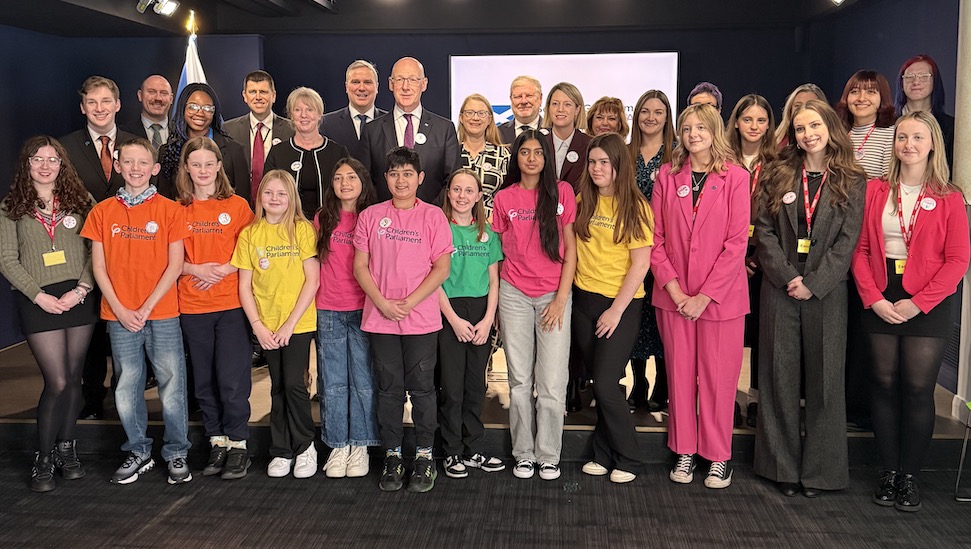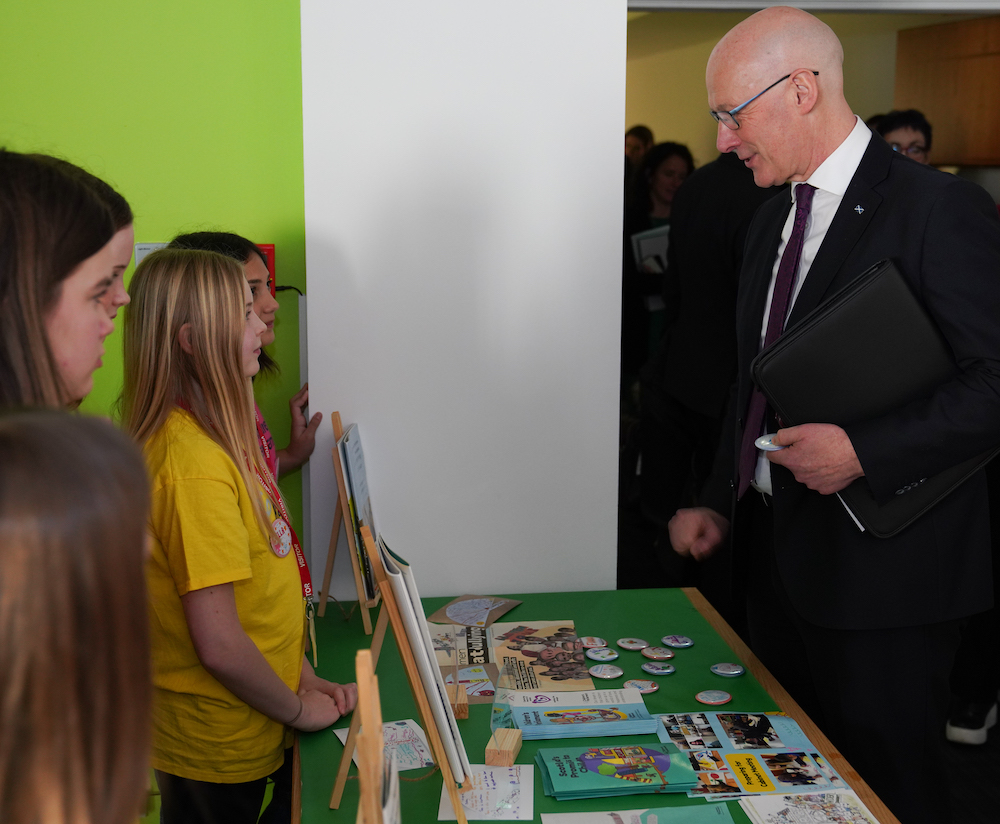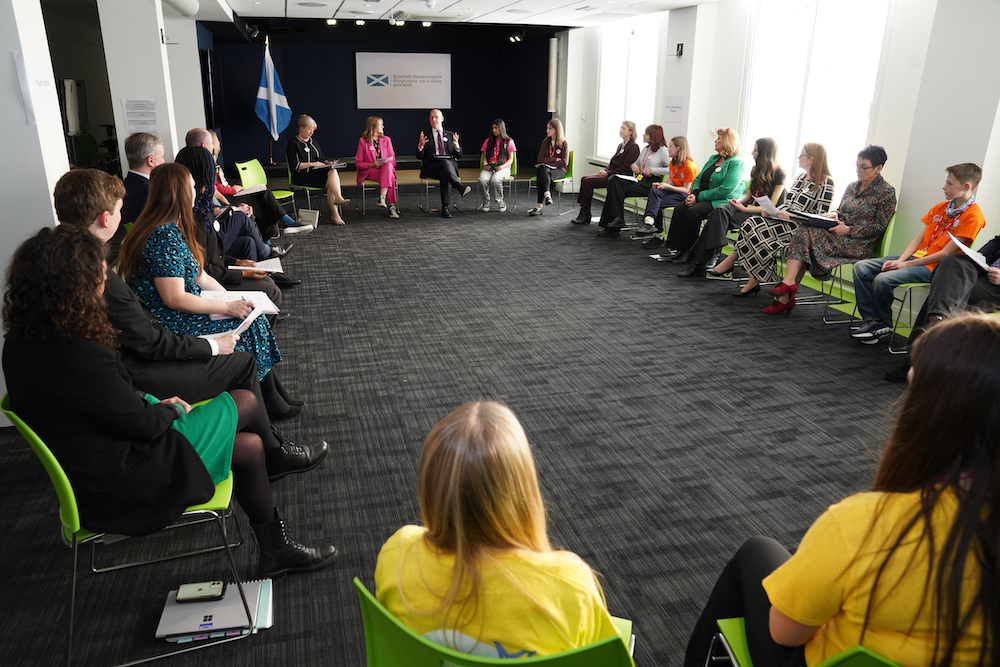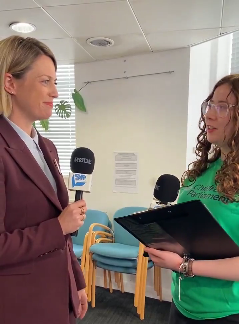Arden Connor joined Children’s Parliament when she was 9 years old, supporting a project to improve services in Edinburgh. Since then, Arden went on to become a Child Human Rights Defender, attending Cabinet and the UN Committee the Rights of the Child. Now aged 16, Arden is a young ambassador for Children’s Parliament.
Arden joined us at our 2024 annual Cabinet meeting to capture the meeting from a child’s perspective. She came along for a preparation day, and the meeting itself – interviewing Members of Children’s Parliament, the First Minister and the Minister for Education. Arden wrote this blog to reflect on what she saw.
On the 19th of November 2024, children from all over Scotland met with the Scottish Cabinet to discuss issues important to children throughout Scotland. This meeting is particularly important for a few reasons: firstly, it is the only time of the year where the entire Cabinet team talk face to face with children, and secondly, as Ellie from the Scottish Youth Parliament said during the opening of the meeting, it is the only example where children and young people meet with a government Cabinet that we know of in the world.

Even though the meeting takes place on one morning a year, months of work and preparation from children, Children’s Parliament staff, teachers, parents and many other people behind the scenes go into making each meeting possible. This year, over 175 Members of the Children’s Parliament were surveyed on the topics that are most important to them. A group of Members of Children’s Parliament – the Child Human Rights Defenders – then researched and prepared to talk about these issues that children throughout Scotland found most pressing. This group of MCP’s was made up of Rida, Evie, Tate, Kati, Ella, Flynn, Humza, and Amber, travelling from Dundee, Aberdeen, Perthshire and East Lothian. Together they make up this year’s cabinet group.
This year children across Scotland felt most strongly about bullying and mental health in schools, climate crisis education, and vaping. After hearing these issues, the Child Human Rights Defenders then held workshops in their schools to get evidence for their calls to action and to better understand how these issues impact children.
To show their ideas to the Scottish Cabinet, each Member of Children’s Parliament made a flower with their calls to action on it. For example, Flynn wanted to “involve children in climate education” so children’s views and ideas could help shape a better climate education that all children understand and learn from.
When Children’s Parliament first arrived at St Andrews House, the first thing they did was set up a garden to display all their flowers with the Calls to Action and other props. There were vines on the doorway, ‘grass’ carpets, bean bags, and even stuffed toys! The children chose to decorate the room this way so it would be more child friendly. This was helpful because it made it easier for the children to relax, but also helped the adults remember how it felt to be a child. This made it so meaningful conversation could be had without the pressure of a typical business meeting, set up with scary, tall adults in suits around a big table.

Children’s Parliament also set up a table full of colourful leaflets describing their projects and what the Members of Children’s Parliament had been up to. They also made and decorated a badge for each member of the Cabinet, which they handed to them as they came in. They did this so they would know who everyone was and what job they did. All the children also wore their own fun nametags, so everyone knew who they were.
Before the meeting, I was able to interview the Members of Children’s Parliament, and they told me that they felt nervous, which is understandable, with how important a meeting this is for all the children and young people all over Scotland. They were also excited to have the opportunity to make a difference and to share their ideas. Rida was keen for decision makers to take away ‘all of their calls to action’ and for the Cabinet to make it so children are taught about mental health in schools. Ella wanted them to “increase children’s knowledge and understanding of vapes” most.
When asked how they wanted tomorrow to go, Rida hoped that “they would ask questions, so we know they are listening to us and not seem bored.” She also said that it’s incredibly important to have meetings like this “so they get a perspective what children think” and “so when they are making decisions, they take us [children] into account and how it will affect us [children].”
Ella hoped “the Cabinet would engage with things they will be saying” and that the meeting will “make a good difference for everyone.” She thought the meeting was very important because it’s the only chance for the Cabinet to hear “what we have to say.” This made her feel happy because she was being listened to and taken seriously by decision makers, which is an opportunity most children don’t get. She thought making the meeting room into a child-friendly space is important because then the “conversations will be better.” Rida thought the child friendly space would be beneficial because “then we will be more comfortable because it’s our space.” Both Rida and Ella hoped that because of the meeting, decision makers will want to engage more with children.
To start the meeting, Children’s Parliament, Scottish Youth Parliament, and the Scottish Cabinet sat in a big circle. Rida (one of the amazing Members of Children’s Parliament), Ellie (from Scottish Youth Parliament), co-chaired the meeting, alongside John Swinney, the First Minister. Everyone in the circle went round introducing themselves so everyone was acquainted and comfortable. Once the circle broke, the Children’s Parliament went through to their ‘garden’ while the Cabinet and Scottish Youth Parliament had their meeting. This gave the Members of Children’s Parliament some extra time to run through their presentation beforehand.

Once the Cabinet stepped through the vines into the ‘garden’, the meeting begun and Rida introduced the Calls to Action. The children each then spoke about their issue while the Cabinet stood and listened respectfully. The first issue was Climate Crisis Education which Flynn and Amber spoke about. They found this issue particularly important because as Flynn said, “children are worried about climate change.” Flynn and Amber even suggested having a ‘child friendly tab’ on the Scottish governments website so children can read and understand what going on.
Next Evie and Tate spoke about Bullying and Mental Health in Schools, they emphasized how crucial it is to teach adults in schools how to prevent bullying and its impact because as Evie said, “We know it’s a big problem for children and young people.” She also said it was crucial to have child-friendly resources on how to cope with mental health and bullying. Tate also felt very passionate about mental health saying, “Primary schools need to teach mental health. We aren’t bad kids; we just need to speak to someone.”
The final issue presented this year was vaping and it was presented by Kati, Ellie, and Hamza. They highlight how many vapes are advertised to children with bright colors and sweet flavors and how many shops don’t ask for ID and sell to children. They explained to the Cabinet how many children don’t know the long-term effects of vaping and some even considered them healthy due to fruity flavors. Kati said that: “We like what you guys [Scottish Government] are doing but we think you can do more.”
After that, the children and adults broke into smaller groups where they could talk more in detail about the issues. The members of the Cabinet seemed really engaged and spoke lots to the Members of Children’s Parliament about the issues and their ideas for solutions as well as giving their own questions, solutions and what they are already doing. To me, this was one of the most meaningful parts of the entire meeting as the Cabinet really got a sense of how important these issues are to the children, not just in the room but all over Scotland. The only way I think it could have been better is to have more time for these conversations and questions. I think the most interesting question asked was by the First Minister; during one of the breakout groups. He asked: “Do you feel your voice can be heard?” to which Amber replied, “If it doesn’t work the first time we can just keep trying.”
Each member of the Cabinet then planted a bulb to represent what they are going to do after hearing the children’s ideas. Once it sprouts in Spring, they will get back in touch and say what they have been doing. During the conclusion, John Swinney spoke about how important it is to have this meeting “so we can hear directly and exactly what you are thinking about.” He also commented on how the Cabinet Garden “was a place of happiness, and joy, and stimulating conversation.” Rida finished the meeting on a powerful note by saying: “Please don’t let this go to waste. Please don’t let us down.”

After the Cabinet meeting, I had the amazing opportunity to interview the First Minister, John Swinney, and the Secretary for Education and Skills, Jenny Gilruth. I asked them both important questions about how they felt about the meeting and their next steps after. It felt incredible to be able to ask the questions other children and myself want to know in a clear straight forward way, and I wish more children got the chance to so it could be easier for all children and young people to know what is going on in their government. I believe it is so important to have children input into the highest part of the government because they are also citizens of Scotland who need to be represented and cared for, and this can’t be done unless they are given the opportunity. Children know best what they need and what it’s like to currently be a child, they are the experts on being a child, and so why not include them in the decisions that affect them? Almost every decision the government makes affects children’s lives, therefore it is important that their views are taken into account. Childhood is one of the biggest factors that affect our later lives which is what makes it so crucial that everyone gets the best start they can.
Arden interviewed the First Minister and the Minister for Education as part of her visit to St Andrew’s House with us. You can see her interview with the First Minister here:
https://www.youtube.com/watch?v=YWyeqcTE7iE&t=2s
You can see her interview with Jenny Gilruth, Minister for Education, here:
https://x.com/Creative_Voices/status/1859572274463981928
To find out in more detail about the Cabinet meeting and the children’s calls to action, please visit: childrensparliament.org.uk/childrens-parliament-meets-the-scottish-cabinet/
This blog is the second in a series of four. To read more, please visit:
Blog 1 – Journey to the Annual Cabinet Meeting
Blog 3 – Hopes for the future of Cabinet
Blog 4 – The Annual Cabinet Meeting on the Global Stage